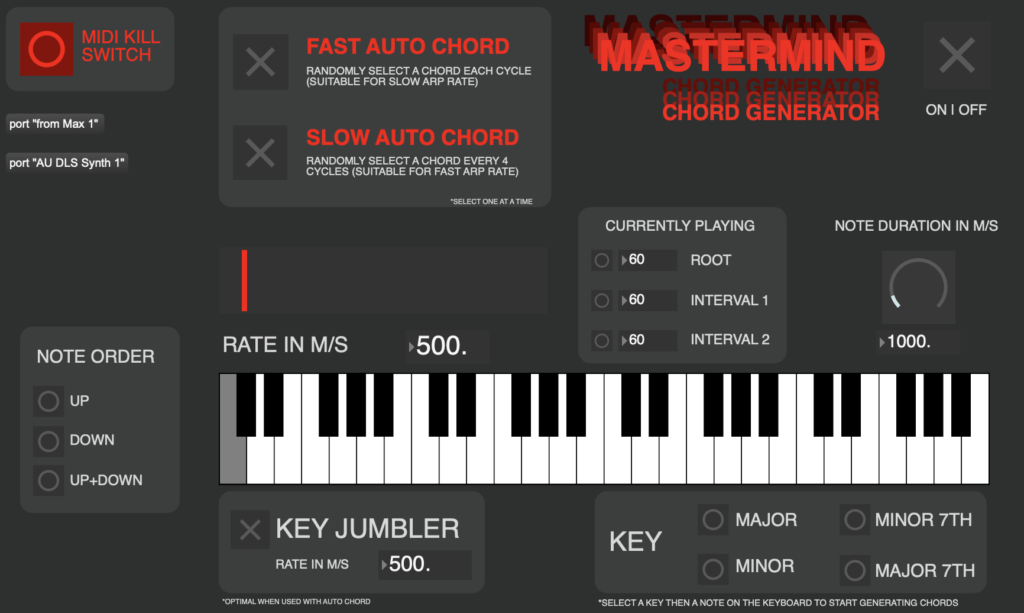Hi.
Welcome to my Thesis project, we’ve got a backstory so buckle up.
Back on May 16th, I submitted a final for Interactive Music Programming. By this point, there was still a sensible hope for us to return to campus, but there was also a non-zero chance we wouldn’t. The ideas I had for thesis at the time would’ve relied heavily on campus resources, so knowing I would need a good backup, I tucked the project away in a folder on my desktop.
There were two big reasons I knew I should keep a tab on this project:
1: The project was carried out from start to finish during remote learning.
2: It had potential beyond the scope of the final it was being submitted for.
And now, here we are. With my pessimism reigning victorious, it at least paid the favor of giving me a skeleton to work with for my Thesis.
So what is it?
Well first off, it was a group project, but I’ll talk a bit down the line how I’ll be handling the chunk that I didn’t work on firsthand. Beyond that, I’ll let my past self do the talking…
“To sum up, our project is effectively two separate MAX modules that ‘patch’ together to create a generative music system that can be modulated with a variety of effects. The path starts with my patch, which serves as the MIDI controller, and feeds the MIDI data into Logic. In Logic, we have a repository of several Helm patches to choose from that we each designed, ultimately functioning as the instrument of the system. Finally, we use Soundflower to route the audio being outputted from Logic into Danny’s patch, which can process the audio with a series of effects ranging from a delay to a ring modulator. All together these can be used to generate unique ambient music, or if you prefer, heavily distorted drone. That being said, the instruments were designed in line with our own tastes, but by incorporating a DAW as a key feature, this unleashes the potential for the use of our interactive music system.”
If that doesn’t make a whole lotta sense, fair enough. Here’s a demo that hopefully clears up what exactly this is:
That brings us up to speed with today, so…
What’s going on with this now?
Well, as far as implementation goes, nothing so far…
but,
I do have a layout for how I’m going to turn this into a thesis worthy project. The first step is renovation, and currently that is in the idea generation stage. This stage is all about taking the good from this project, and making it better.

In this stage, I’ve had several sessions of just messing around with the system, and getting a candid perspective of using it in a solely creative context. Along the way, I’ve been jotting down the things I wish it did, or things about it that bother me. I’ve held off on implementation so that I could both make sure that I’ve covered any potential overlap in ideas, and to streamline the implementation process. This is a consequence of many visual programming languages, but programming in MAX can get real messy very quickly, so knowing how to implement these changes is just as important as the changes themselves.
How about down the line?
The next step after renovation is dissecting the other half of the system. Essentially, the other half is an effects rack, which is simple enough for a musician that understands effects to follow. But, given the nature of my patch, I want to maintain the user friendly feel, and that includes non-musicians. Effectively, I would be splitting up the effects into their own patches, and providing clear labelling for the different ways that effect can be manipulated.
From there, I’m looking expand the instrument bank in Logic Pro X to be more comprehensive. The system works with any DAW that inputs MIDI, so this isn’t absolutely necessary for the project, but it’s there to serve the purpose that the presets on a synthesizer would.
Past that, the view into the future of this project starts to blur. By this point, the bare necessities will have been covered, so what’s next?
The possibilities range from anything to creating compositions using the system, to completely redoing its visual design, to using it to help others with their projects.
For now, we’ll just have to wait and see what the future holds.
This looks real neat “Brandon”. I don’t entirely understand what I’m looking at but I know it sounds really cool and, for less song-based genres, quite useful. If we were doing the RWJH project, this would be killer.
I guess my question is: What purpose would this serve when it’s done? Is there any intention to make this usable in a traditional songwriting context, or is it more geared towards performance?
Fair question, while it’s definitely more consistently tonal when creating ambient type stuff, it’s ultimately just an arpeggiator, so it still has a place for songwriting. This has always existed in my head like one of those crazy Organelle patches, so it’s purpose generally reflects that. One of the focal points of this is where it does and doesn’t limit functionality, and the goal of that is to encourage creativity since you can’t really play it like typical keys. While I probably wouldn’t write with this in a traditional sense, there can be lots of a-ha type moments from goofing around with it since it doesn’t function like an instrument typically would.